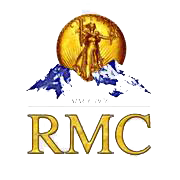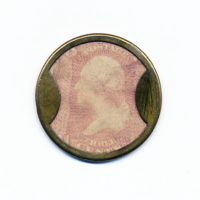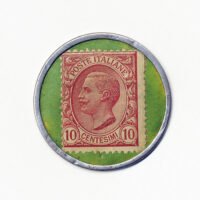Encased Postage
By early 1862, the US was fully engulfed in the Civil War. Many people began conserving resources due to the uncertainty of not knowing how much longer the war might last. Among the most hoarded items of the day – coins.
Sold inventory is kept on our website for reference purposes.
Please call or visit our showroom for the latest price and availability.
On August 12, 1862 John Gault patented a method for encasing postage stamps in a brass case with a mica cover that allowed viewing of the stamp inside, he named the item in a newspaper advertisement, the “New Metallic Currency”. The 1¢, 2¢, 3¢, 5¢, 10¢, 12¢, 24¢, 30¢ and 90¢ stamps of the 1861 issue were encased and used as coinage.
Gault’s process required machines that started with a round piece of brass (about the size of a quarter) as the backing, and then layering on a piece of cardboard, a stamp, a piece of mica (as a clear covering for the stamp), and finally another piece of brass with a hole in it, the button machine would press the pieces together to create the encased stamp. The final step in the process was for the machine to bend over the edges of the frame to keep the pieces inside the case.
Stores and manufacturing companies such as Ayer’s Pills, Burnett’s Cooking Extracts, and Lord & Taylor began impressing their name and product on the back of the metal frame and began using them for advertising. At least 30 different companies took advantage of this new advertising tool.
Encased stamps were widely accepted in the general commerce realm until later in 1862 when the government issued “fractional currency”, bills with values of less than one dollar. This legitimate, government sanctioned currency quickly eliminated the coin shortage. Having no other value than the stamp, people tore apart the encasement’s of their metallic currency to remove the stamp to use as postage. Thus, the scarcity of 1862 encased stamps today.
Foreign Encased Postage Stamps
In the early 20th century, encased postage stamps were used in Denmark, France, Austria, Germany, and Italy. Similar to the purpose of the encased stamps used during the U.S. civil war, these metallic currencies hoped to solve a coinage shortage due to wars and other territorial conflicts


